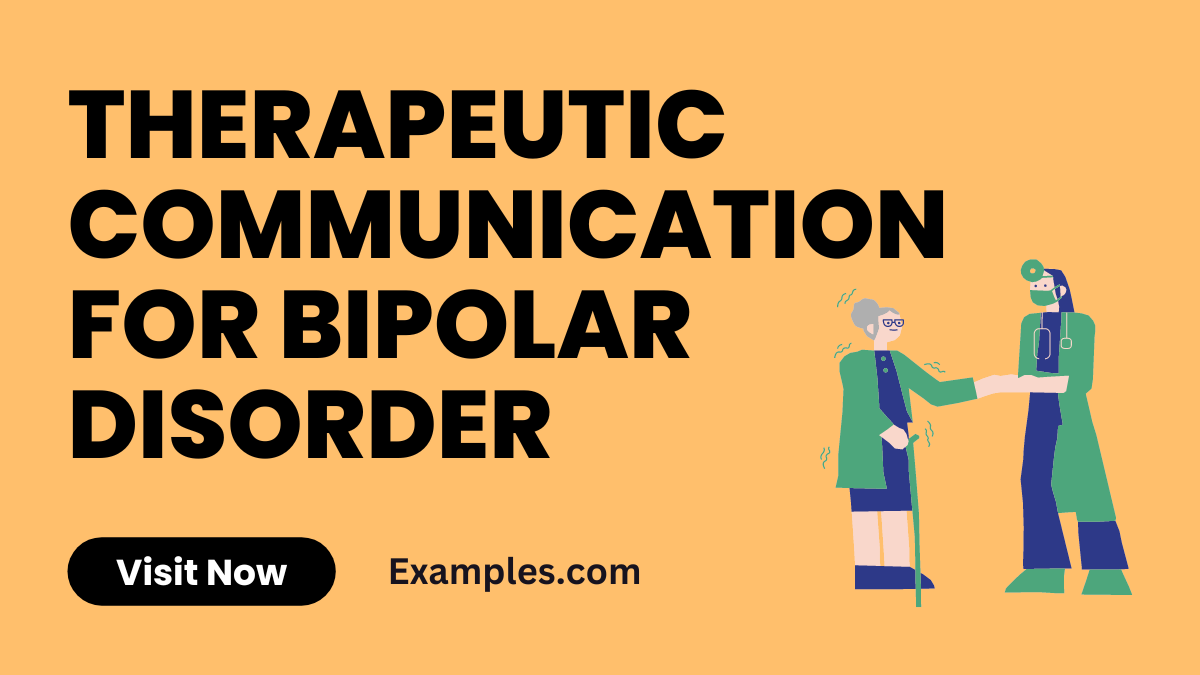14+ Therapeutic Communication for Bipolar Disorder Examples
This guide offers a deep dive into the nuances of therapeutic communication specifically tailored for bipolar disorder. With a collection of practical and real-life examples, it illuminates how specialized communication techniques can significantly aid in managing the unique challenges posed by bipolar disorder. The focus is on empathetic, effective dialogue strategies that foster understanding, support, and a strong therapeutic relationship between caregivers and those living with bipolar disorder.
What is Therapeutic Communication for Bipolar Disorder?

Therapeutic communication for bipolar disorder refers to the specialized methods used by healthcare professionals to interact effectively with individuals who have bipolar disorder. This communication style is empathetic, patient-centered, and adapted to address the specific emotional and psychological needs of people experiencing the fluctuating moods and behaviors associated with bipolar disorder. It’s about creating a supportive dialogue that respects the patient’s experiences while aiding in their treatment and recovery.
What is the Best Example of Therapeutic Communication for Bipolar Disorder?
The best example of therapeutic communication for bipolar disorder might involve a healthcare professional acknowledging and validating the patient’s feelings during both manic and depressive episodes, without judgment. For instance, saying, “I see that you’re feeling extremely energetic today, let’s talk about how that’s affecting you,” during a manic phase, or “It sounds like you’re feeling very low today, can you tell me more about that?” during a depressive phase. This approach demonstrates understanding and provides a safe space for the patient to express their feelings and challenges.
15 Therapeutic Communication for Bipolar Disorder Examples
Therapeutic communication examples tailored for bipolar disorder. This section is a treasure trove of specific, empathetic communication strategies designed to resonate with individuals experiencing the highs and lows of bipolar disorder. Each example is crafted to guide healthcare professionals in building a strong, supportive relationship with their patients, using words and actions that convey understanding, compassion, and a commitment to their well-being.
- During a manic episode: “I can see you have a lot of energy right now. Let’s channel it into something positive.” This acknowledges their current state and suggests a constructive outlet.
- During a depressive phase: “It sounds like things are really heavy for you right now. I’m here to listen.” This validates their feelings and offers support.
- Encouraging self-awareness: “Can you describe how you’re feeling right now?” Asking patients to articulate their emotions helps them gain self-awareness and feel heard.
- Discussing medication: “How do you feel about your medication? Are there any concerns?” This invites open dialogue about treatment, showing respect for their input.
- Addressing sleep patterns: “How has your sleep been lately?” Discussing sleep can reveal important mood indicators and daily challenges.

- Talking about triggers: “What tends to make your mood swing?” Understanding triggers helps in managing the disorder more effectively.
- During rapid mood swings: “I notice your mood has changed quickly, how does that feel for you?” Acknowledging rapid changes helps in understanding their experience.
- Setting realistic goals: “What’s one small goal we can set for today?” This helps in focusing on achievable tasks, providing a sense of accomplishment.
- When they express frustration: “It’s understandable to feel frustrated. Let’s work through this together.” This validates their emotions and offers partnership in finding solutions.
- Discussing support systems: “Who do you feel you can turn to when you’re feeling down?” Encouraging them to identify support systems strengthens their network.
- Reflecting on past successes: “Remember when you overcame a similar challenge?” Reminding them of past successes can boost confidence and hope.

- Exploring hobbies and interests: “What activities make you feel good?” Encouraging them to engage in enjoyable activities can improve mood and provide distraction.
- When they feel overwhelmed: “Let’s take a moment to breathe together.” This provides immediate support and a technique to manage overwhelming emotions.
- Addressing substance use: “How does using [substance] affect your mood?” Discussing substance use can uncover its impact on their bipolar disorder.
- Offering consistent reassurance: “I’m here for you, no matter how you’re feeling.” This reinforces the message of unwavering support and understanding.
Therapeutic Communication for Bipolar Disorder Examples in Patients
-
Reflective Listening:
“It sounds like you’re feeling overwhelmed right now, is that correct?” This technique involves echoing the patient’s feelings or thoughts to show understanding and validation.
-
Validating Emotions:
“It’s completely understandable to feel anxious about these changes.” Validation acknowledges the patient’s emotions, promoting a sense of empathy and connection.
-
Offering Reassurance:
“You’re not alone in this; we’re here to support you every step of the way.” Reassurance provides comfort and reduces anxiety, fostering a supportive therapeutic relationship.
-
Clarifying Information:
“Could you tell me more about what you mean by ‘feeling on edge’?” Asking for clarification helps ensure understanding and addresses any miscommunication.
-
Encouraging Expression:
“I would like to hear more about your experiences during these mood swings.” This encourages patients to share their feelings and experiences openly, promoting a deeper understanding.
What are Therapeutic Communication Techniques for Bipolar Disorder?
- Active Listening: Involves paying full attention to the patient, demonstrating genuine interest in their experiences. This technique not only helps in understanding the patient’s perspective but also conveys empathy and respect. Incorporating nonverbal communication cues, like nodding and maintaining eye contact, enhances active listening.
- Reflective Statements: Using reflective statements involves mirroring the patient’s feelings or words back to them. It’s a way of showing that their emotions are heard and understood, which is crucial in managing emotional communication in bipolar disorder.
- Open-Ended Questions: Asking questions that cannot be answered with a simple ‘yes’ or ‘no’ encourages patients to elaborate on their thoughts and feelings. This technique is instrumental in understanding the nuances of their experiences with bipolar disorder, including aspects of intrapersonal communication.
- Clarification: Sometimes, what a patient says may be ambiguous or unclear. Seeking clarification ensures that the healthcare provider accurately understands the patient’s message, minimizing miscommunication.
- Summarizing: This involves restating the key points of what the patient has shared. It not only confirms that the message has been correctly received but also helps in organizing the patient’s thoughts, which can be particularly helpful given the communication barriers often experienced in bipolar disorder.
How Can Therapeutic Communication Benefit Individuals with Bipolar Disorder?
- Enhances Understanding and Insight: Through therapeutic communication, patients gain a better understanding of their condition and treatment. This insight is crucial for managing bipolar disorder effectively and involves integrating knowledge about communication objectives and communication styles.
- Builds Trust and Rapport: A strong therapeutic relationship, underpinned by trust and rapport, is essential for effective treatment. By employing techniques like empathetic communication and active listening, healthcare providers can create a safe and supportive environment.
- Reduces Stigma and Isolation: By normalizing the experiences and feelings associated with bipolar disorder, therapeutic communication helps in reducing the stigma and feelings of isolation that patients often face. Inclusion of internal communication strategies and understanding communication barriers is key in this process.
- Encourages Adherence to Treatment: When patients feel heard and understood, they are more likely to adhere to their treatment plans. Effective therapeutic communication involves not just listening, but also engaging patients in discussions about their treatment, thus enhancing patient-centered care.
- Aids in Crisis Management: During episodes of extreme mood swings, effective communication can be a lifeline. Techniques like crisis communication and nonverbal communication play a vital role in managing these critical situations.
Understanding and effectively using therapeutic communication techniques is vital for managing bipolar disorder. This comprehensive guide offers valuable insights and practical examples to aid healthcare professionals. Emphasizing empathy, active listening, and patient engagement, these strategies not only improve care but also foster meaningful connections, enhancing treatment outcomes for individuals with bipolar disorder.



